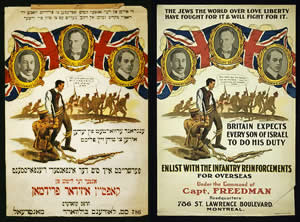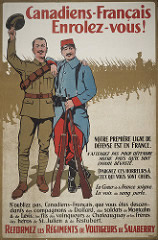Languages Stage 4
Overview

Yiddish and English versions of First World War recruitment posters directed at Canadian Jews, 1914–1918
©Public Domain (Library of Congress LC-USZC4-11300), LC-USZC4-12406)
Students use primary sources to research examples of propaganda posters in the target language. They examine how language, symbols and images convey the message. Students design their own poster considering symbols, images, colours and the message to be conveyed.
Teaching and learning activities

Canadiens-Français enrolez-vous! Canadian Army, 1914–1918.
How do language, symbols and images convey meaning in First World War recruitment and propaganda posters?
Students:
-
Using primary sources, research examples of propaganda posters in the target language. How do the language and images convey the message?
-
Select a poster and explain the purpose. Identify the ways in which the language and images convey meaning?
-
Who is the audience for the poster?
-
What language is used to convey the message? Recognise words that can be translated.
-
Identify specific characteristics of language. What grammar tense is used? Make a list of common words.
-
Identify features of the lifestyle during the First World War, for example, gender roles, stereotypes.
-
Research and design a poster. Students design their own poster, thinking about symbols used, colours and message to be conveyed.
Learning concepts
These additional questions can be used for discussion or further investigations.
Challenge
How is a strong recruitment or propaganda message communicated in the form of a poster?
Change
What communication methods and media were available in the First World War? How does that compare to the present?
Community
How do the language and images convey the message in First World War recruitment and propaganda posters?
Syllabus links
Making Linguistic Connections
4.MLC.1 A student demonstrates understanding of the importance of appropriate use of language in diverse contexts.
Students learn about:
-
appropriate choices made to achieve communication goals
-
the importance of recognising audience in communication
-
specific grammatical concepts that operate across languages
-
metalanguage to describe the structures and features of language
Moving Between Cultures
4.MBC.2 A student demonstrates knowledge of key features of the culture of (language)-speaking communities.
Students learn about:
-
ways in which language and behaviour reflect important aspects of the culture
-
the importance of tradition to a sense of cultural identity and diversity within the culture
-
representations of the culture of (language)-speaking communities in text and film, mass media
-
collecting and interpreting electronic information, with consideration of its ethical use, in order to identify and reflect on representations of culture